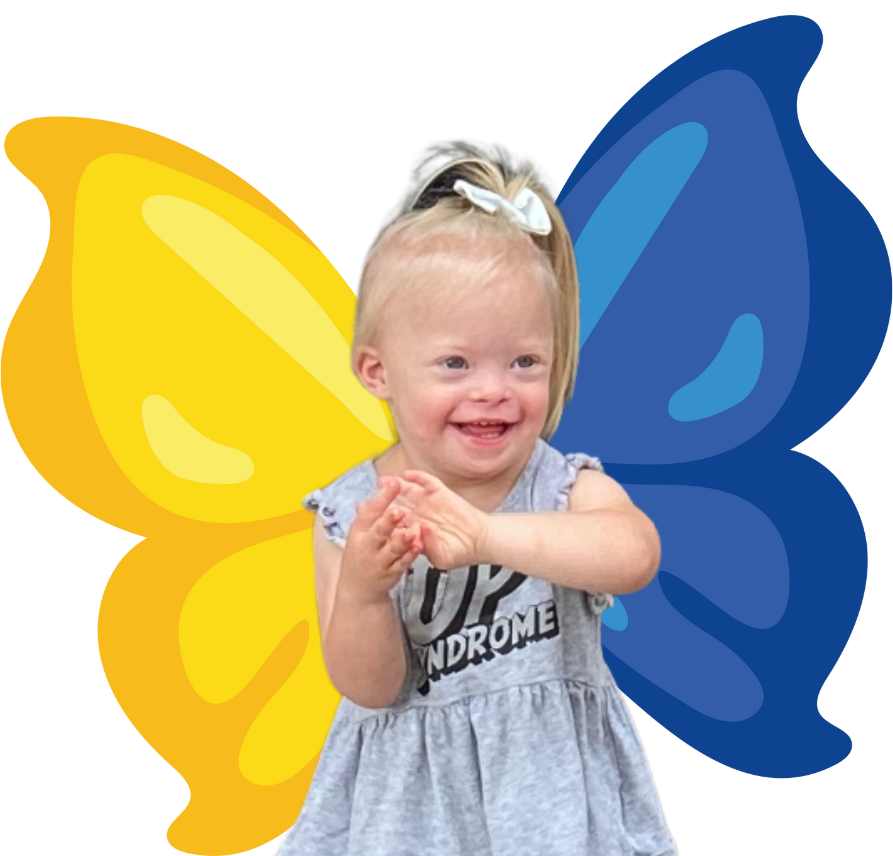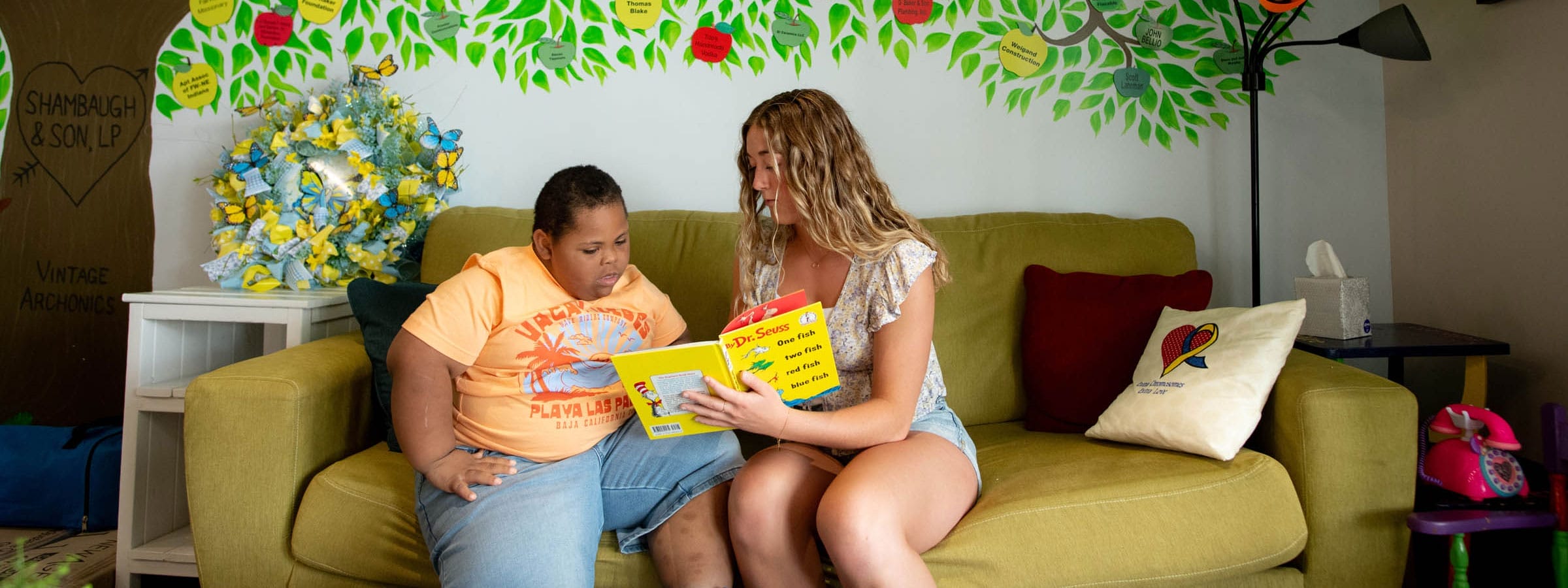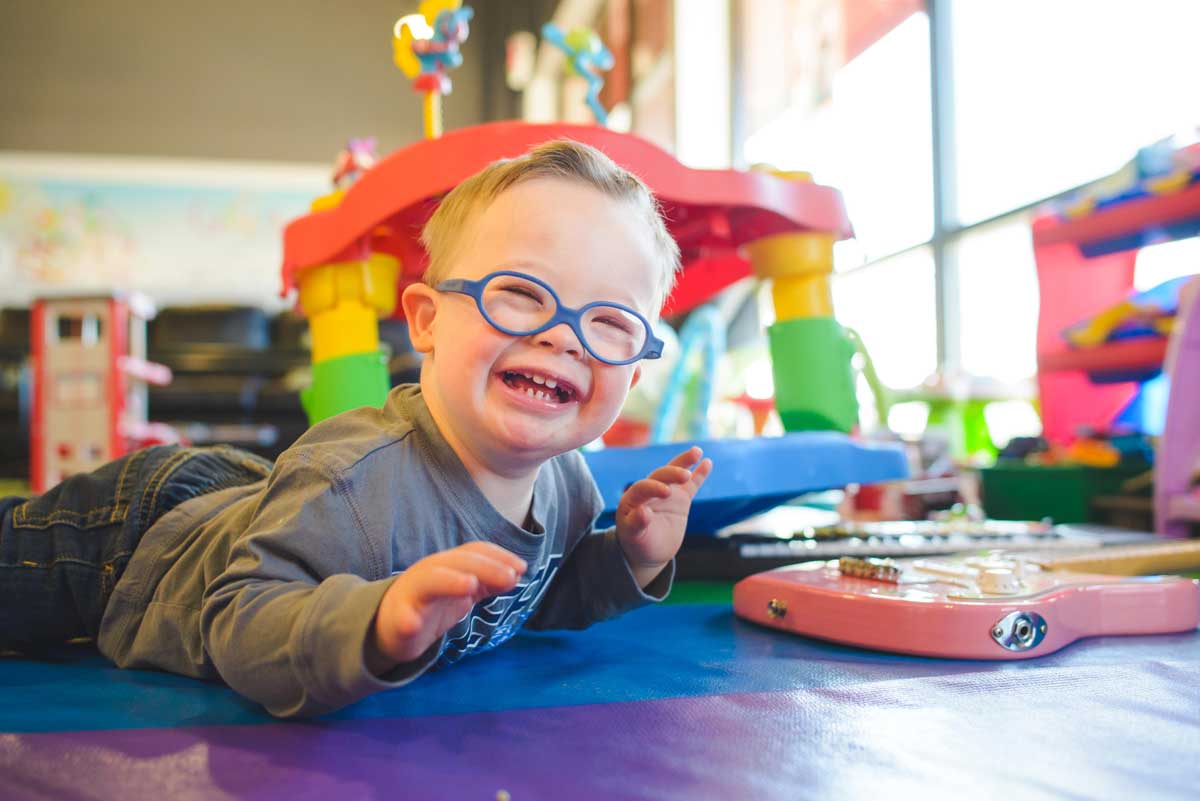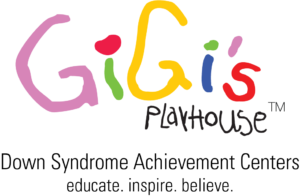What Is Down Syndrome?
A Complete Guide for Families, Educators, and Advocates

Finding accurate information about Down syndrome can be difficult. Although there is an abundance of information about Down syndrome online, it's often outdated or confusing. This often leaves families, educators, and curious learners with more questions than answers.
At GiGi's Playhouse, we understand why it's critical to learn correct, up-to-date facts about Down syndrome.
For over 22 years, our network of Playhouses across the US and Mexico has provided free educational, therapeutic, and career training programs for individuals with Down syndrome and their families. We've seen thousands of parents, siblings, grandparents, and caregivers walk through our doors, many with uncertainty and questions. And we've proudly stood alongside them, offering answers, hope, and support.
That's why we've prepared this comprehensive Down syndrome guide. Whether you're a new parent, a friend, or just looking to learn, this complete guide will:
- Help answer the question, what is Down syndrome?
- Know what to expect
- Discover where to find support
- Break down common misconceptions
- Share Down syndrome facts you can trust
We'll also shine a light on the beautiful, diverse lives of people with Down syndrome.

What Is Down Syndrome?
We get it. Learning about Down syndrome for the first time can feel intimidating. You're often faced with unfamiliar terms, medical jargon, and clinical language. But we're here to make it easier.
Down syndrome is a genetic condition. As complex as that may sound, it has a straightforward explanation. Typically, people are born with 46 chromosomes, but individuals with Down syndrome have 47. Down syndrome occurs when a person is born with an extra copy of chromosome 21, also known as Trisomy 21. That extra genetic material influences the way the body and brain develop.
Trisomy 21 can lead to mild to moderate cognitive and developmental delays in areas including communication, motor skills, and learning. Certain physical traits, like almond-shaped eyes or low muscle tone, are also common in individuals with Down syndrome.
But it's important to note that individuals with Down syndrome are unique. They each have their own personalities, interests, and strengths. While their diagnosis is a part of who they are, it does not define them.
That's why we use people-first language. People-first language means saying "a person with Down syndrome" instead of "a Down syndrome person." This simple shift puts the person before the condition, recognizing their humanity and individuality first.
While Down syndrome is a lifelong genetic condition, the long-term outcomes for individuals with Down syndrome have improved dramatically in recent decades. Advances in healthcare, early intervention, and inclusive education have significantly enhanced the quality of life and opportunities for independence for people with Down syndrome.
What Causes Down Syndrome?
There are a lot of myths and misunderstandings about what causes Down syndrome, but the truth is simple: nothing a parent does before or during a pregnancy causes Down syndrome. Down syndrome happens by chance at conception and cannot be prevented.
While maternal age may increase the likelihood of having a baby with Down syndrome, most babies with Down syndrome are actually born to women under the age of 35. In fact, the average age of a mother having a baby with Down syndrome is 28.
So, how does it happen? It all comes down to chromosomes. Every person with Down syndrome has an extra copy (or part of a copy) of chromosome 21, but that can appear in a few different ways.
Here's a breakdown of the three types of Down syndrome:
- Trisomy 21 is the most common type and accounts for about 95% of cases of Down syndrome. Trisomy 21 occurs when a person has three full copies of chromosome 21 in every cell.
- Mosaicism occurs when some cells have the typical two copies of chromosome 21, while other cells contain three copies. Mosaicism is rare and, depending on the distribution of the affected cells, may result in fewer characteristics of Down syndrome.
- Translocation occurs when an extra part (or a full copy) of chromosome 21 attaches to a different chromosome. This type accounts for about 3–4% of Down syndrome cases. Unlike the other types, translocation can sometimes be inherited from a parent who carries a genetic rearrangement, even if they don't have Down syndrome themselves.
Understanding what causes Down syndrome – and the different types – can help families feel more informed as they navigate a diagnosis.
How Is Down Syndrome Diagnosed?
No matter when it happens, receiving a Down syndrome diagnosis can be life-changing. It brings a flood of emotions, questions, and a need for answers… fast.
Understanding how a diagnosis is made can help bring clarity in an otherwise uncertain time.
Down syndrome can be diagnosed both during pregnancy (prenatally) and after birth (postnatally). Thanks to advances in medical testing, Down syndrome can often be detected early and with increasing accuracy.
Here's how the process works, before and after birth:
Prenatal Testing
There are two main types of prenatal tests:
- Screening tests estimate the chance that a baby has Down syndrome. These include blood tests and ultrasounds, usually done in the first or second trimester.
- Diagnostic tests, such as chorionic villus sampling (CVS) or amniocentesis, analyze the baby's chromosomes directly. These tests can confirm a diagnosis with near 100% accuracy, but they are more invasive and carry a small risk.
Postnatal Diagnosis
After birth, a Down syndrome diagnosis is often suspected based on physical characteristics. The diagnosis is then confirmed through a chromosome analysis called a karyotype, which examines the baby's DNA.
Processing the Diagnosis
Whether the diagnosis comes prenatally or postnatally, it often comes as a shock to families. It's completely natural for families to experience a wide range of emotions: grief, confusion, or fear. These feelings are valid. But no one has to navigate a Down syndrome diagnosis alone.
There are sources of support available for those processing and trying to wrap their heads around a diagnosis: healthcare providers, genetic counselors, local Down syndrome organizations, and national advocacy groups. GiGi's Playhouse is a proud part of that network, offering free programs and support to individuals with Down syndrome and their families from day one.

Down Syndrome Characteristics and Strengths
Every person with Down syndrome is unique; they have their own strengths, personality, and pace of growth. Still, there are some physical characteristics and developmental patterns that are common in people with Down syndrome.
It's important to remember that these traits vary widely from person to person, and no single characteristic defines someone or their capabilities.
Common Physical Characteristics
People with Down syndrome may share some of the following physical features:
- Almond-shaped eyes that slant upward
- A flatter facial profile or nasal bridge
- Low muscle tone (hypotonia)
- A single deep crease across the palm
- Smaller hands, feet, or ears
- Shorter stature
While these traits may be associated with Down syndrome, they do not determine a person's capabilities or potential.
Learning and Development
Learning with Down syndrome often follows a different timeline, with many individuals experiencing mild to moderate developmental delays in areas like speech, motor skills, or cognitive processing. However, with the right support, structure, and expectations, individuals with Down syndrome can – and do – make significant progress in school, work, and daily life.
Many people with Down syndrome are visual learners. They benefit from repetition and thrive in hands-on, multi-sensory learning environments. Tailored educational strategies and therapies can greatly benefit individuals with Down syndrome.
Living with Down Syndrome: What to Expect at Every Age
Down syndrome is not a one-size-fits-all diagnosis. It's a lifelong journey of unique challenges, milestones, and successes. That said, many families experience common developmental stages and milestones together.
Understanding what to expect at different ages can help caregivers, educators, and healthcare providers more effectively support individuals with Down syndrome.
Infancy (0–12 months)
In the first year of life, babies with Down syndrome often experience low muscle tone (hypotonia), which can affect feeding, motor development, and sleep. Early intervention is key during this stage.
Physical therapy, speech therapy, and developmental therapy can help support important milestones such as head control, sitting up, crawling, walking, and beginning to babble.
Toddler & Preschool Years (1–5 years)
Like all toddlers, children with Down syndrome show more personality and independence as they grow into the preschool years. During this stage, communication delays are common, so speech-language therapy remains critical.
Fine and gross motor skills may also develop at a different pace. Occupational and physical therapy can provide valuable support, and inclusive early education settings can foster social and emotional development.
School-Age Children (6–12 years)
Entering elementary school is a time of growth and discovery for all kids, including those with Down syndrome. While they face learning challenges, with the proper support and individualized learning plans, many children with Down syndrome develop literacy, math, and life skills. This stage is also when self-advocacy, friendships, and structured routines are essential in fostering independence.
Teen Years (13–18 years)
Teens with Down syndrome go through the same emotional, physical, and cognitive changes as their peers, though often at their own pace. Social inclusion, life skill development, and conversations about puberty, identity, and future goals become increasingly important. Vocational training, mentorship, and community involvement all help build a foundation for adulthood and independence.
Adulthood (18+ years)
With the right support, adults with Down syndrome can live fulfilling, independent lives. Some pursue employment, further education, or supported living arrangements. Others engage in volunteering, the arts, or advocacy work. Continued focus on health, social connection, and personal growth remains vital throughout adulthood.
No matter the stage of life, individuals with Down syndrome can thrive when they're provided with the right support and opportunities.
Support for Families and Caregivers
A Down syndrome diagnosis doesn't just affect the individual; it affects the whole family. Whether you're a parent, sibling, grandparent, or close friend, it's normal to feel overwhelmed at times.
But you're not alone.
Down syndrome family support is about more than resources. It's about connection, community, and knowing where to turn. From the very beginning, emotional support from other parents, early developmental services, and trusted guidance from professionals can make a meaningful difference for the whole family, including siblings who may also benefit from connection, understanding, and support.
Early intervention programs and therapy services are especially critical in the first few years. These support systems help children with Down syndrome build a strong foundation and give caregivers the tools to advocate for their loved ones’ needs confidently.
Families who seek out connection often find they're stronger for it. From local Down syndrome support groups to national networks like GiGi's Playhouse, community can turn uncertainty into empowerment.
Inclusive Education and Community Involvement
Individuals with Down syndrome can thrive in schools when they're given opportunities to learn, grow, and belong.
Inclusive education for students with Down syndrome goes beyond classroom placement. It means personalized learning plans, collaborative support teams, and a belief in every child's potential. With the right accommodations and high expectations, students with Down syndrome can make strong academic progress, develop lasting friendships, and actively participate in school life.
Tools like Individualized Education Programs (IEPs) help ensure that learning is tailored to each child's strengths and needs. And when students with Down syndrome are included meaningfully, all students benefit.
Beyond academics, community involvement – from inclusive extracurriculars to adaptive programs – gives those with Down syndrome opportunities to build confidence, communication skills, and independence.
For educators looking to build more inclusive classrooms, GiGi's Playhouse offers free, practical training through our Educator Symposium, an online event held twice a year that provides teachers, therapists, and parents with actionable strategies to support individuals with Down syndrome.

How GiGi's Playhouse Helps
…Still with us? We know. That was a lot of information. But when it comes to understanding Down syndrome, knowledge matters. And the good news? You don't have to navigate any of this alone!
GiGi's Playhouse is rooted in a simple but powerful promise: to stand beside every individual with Down syndrome and their families, offering free programming and a lifetime of support.
At GiGi's, we're here for it all. Every stage, every milestone, every setback, and every moment worth celebrating. Whether you're a new parent seeking guidance, a grandparent searching for answers, a sibling who wants to connect, or a community member who simply wants to learn more, you have a place at GiGi's.
With over 60+ Playhouses across the U.S. and Mexico, and our online virtual programming, we provide over 350,000+ hours of educational, therapeutic, and career training programming a year. Our Playhouses are rooted in local communities, but powered by nationally developed programs designed specifically for individuals with Down syndrome.
And the best part? It's all completely FREE of charge. We offer accessible math and literacy tutoring, speech and language therapy, fitness and nutrition programs, career training, social groups, and more.
But beyond free programming, we walk with families through every high and every low.
From hard days to huge milestones, GiGi's is a place where challenges are met with understanding and every achievement is celebrated. Along the way, you'll find a supportive community and lifelong friendships that grow with you through every stage.
Ready to connect?
Explore More Topics
Still have questions? You're not alone.
We've put together more resources to help you keep learning, growing, and supporting individuals with Down syndrome in everyday life.
Call to Action
Now that you've learned more about Down syndrome, you might be wondering what you can do next. No matter who you are, there's a place for you at GiGi's Playhouse!
Explore our FREE programs, connect with your local Playhouse, or get involved — because together, we can make the world a more accepting place for individuals with Down syndrome.
